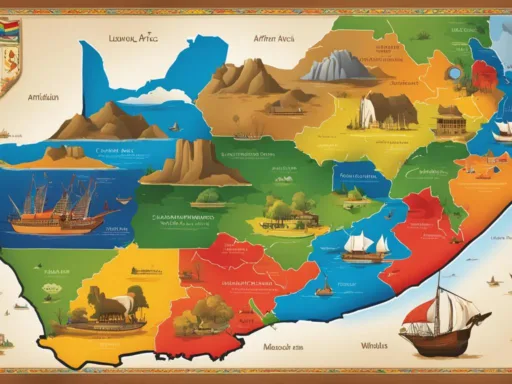Did you know that East Timor, a small nation sitting at the crossroads of the Indonesian archipelago and the Pacific Islands, possesses one of the most biodiverse marine environments on the planet, with gastronomic traditions just as rich and varied? Embarking on an East Timor Food Exploration offers a unique opportunity to chart a course across the global food map, uncovering culinary delights hidden within this emerging tropical paradise. East Timor’s diverse dishes and rich cuisine are waiting to be tasted by adventure-seeking gourmands and cultural enthusiasts alike.
As a nation, East Timor presents an unlikely but compelling character in the story of international gastronomy. With its blend of Southeast Asian warmth and Portuguese zest, every bite tells a story of cultural confluence, resilience, and a zest for life that is truly Timorese. Whether it’s a bowl of fragrant rice or a cup of robust coffee, East Timor’s cuisine invites you on a journey that promises to both challenge and satisfy your palate.
Key Takeaways
- East Timor is a hidden gem on the global food map, offering an array of undiscovered culinary delights.
- The country’s diverse dishes reflect its rich history and cultural influences, including Portuguese and Indonesian flavor profiles.
- East Timor’s rich cuisine is interwoven with its natural and cultural heritage, providing a unique gastronomic experience.
- East Timor Food Exploration is not just about eating; it’s about understanding a nation’s identity through its food.
- Food enthusiasts will find the blend of traditional and modern Timorese lifestyle through the country’s varied tasting plates.
- Discovering East Timor’s culinary scene is a window into the soul of its people and their story of survival and independence.
An Introduction to East Timor’s Culinary Heritage
Rich in history and flavor, East Timor’s culinary heritage encompasses a fascinating blend of native Austronesian roots, Portuguese influences, and Southeast Asian spices. This unique combination has cultivated a vibrant gastronomic landscape that tells the story of its people and their journey through time. The infusion of culinary practices from across the seas has resulted in a food culture that is much more than sustenance—it is a narrative of survival, identity, and celebration.
The Melting Pot of Southeast Asian and Portuguese Flavors
From the touch of cinnamon to the kick of ginger, the Portuguese legacy lives on in East Timor’s kitchens through a bountiful marriage of sweet and spicy aromas. The once colonial presence left behind a recipe book replete with fragrant spices, succulent meats, and rich, hearty stews. Meanwhile, the influence from neighboring Southeast Asian nations has introduced a variety of fresh and fiery flavors, further diversifying Timor’s culinary repertoire.
https://www.youtube.com/watch?v=MQTtY12Hfgs
Echoing the country’s rich yet turbulent history, these cross-cultural flavors are a testament to the resilience and adaptability of the Timorese people. They showcase a deliciously intricate web of culinary exchange—an edible mosaic, where every dish represents a chapter of East Timor’s storied past.
Independence and the Culinary Renaissance
The dawn of independence for East Timor marked the beginning of a Timorese culinary renaissance. Liberated from the shackles of adversity, the nation has been rediscovering and revitalizing ancestral recipes while embracing the newfound freedom to innovate. Communal dining tables groan under the weight of dishes like the creamy caramelizada, a testament to the enduring Portuguese influence, alongside vibrant Southeast Asian-inspired sambals.
Following years of foreign occupation, there is conscious effort to nurture and promote local fare, reflecting a prideful reclamation of East Timor’s cultural identity. Simply put, Timorese cuisine is experiencing a revival, celebrating its flavors with a sense of newfound sovereignty and national pride.
East Timor Food Exploration: A Guide to Timorese Gastronomy
The richness of Timorese gastronomy lies not only in its flavors but also in its cultural significance, reflecting centuries of traditions and a blend of culinary influences. Let’s delve into the heart of traditional East Timorese cuisine by exploring the essential Timorese dishes that define the nation’s palatable heritage.
Essential Timorese Dishes You Must Try
For anyone yearning to experience the real taste of Timor, there are several dishes that embody the soul of Timorese cooking. Ikan pepes is the epitome of local seafood cuisine, with fish marinated in aromatic spices and grilled to perfection. Then there’s babi kecap, a dish beloved for its tender pork simmered in a sweet and savory soy-based sauce. To truly embrace Timorese comfort food, one must savor batar da’an, a homely soup incorporating corn and pumpkin, enriched with the flavors native to East Timor.
Local Ingredients and Cooking Techniques
In the Timorese kitchen, the reliance on local ingredients is paramount. Indigenous vegetables, tropical fruits, and freshly caught seafood form the backbone of many recipes. The traditional cooking techniques employed in East Timor, such as slow-cooking over a wood fire and wrapping food in banana leaves before grilling, lend dishes an unmistakable authenticity. These methods, deeply rooted in Timorese culture, play an essential role in making the cuisine a robust testament to the country’s history and its ties to the land and sea.
The table below compares some of the fundamental local ingredients with the corresponding cooking techniques that give Timorese dishes their distinctive character:
| Local Ingredients | Cooking Techniques |
|---|---|
| Fresh Seafood (Fish, Shellfish) | Grilling on banana leaves |
| Root vegetables (Cassava, Sweet Potato) | Underground pit roasting |
| Coconut Milk | Slow simmering |
| Spices (Tamarind, Lemongrass, Chili) | Marinating and seasoning |
Indulging in Timorese gastronomy takes you on a voyage through time-honored recipes and unrivaled culinary practices. So, as you explore the enchanting landscapes of East Timor, make sure your journey includes the delights of its unique and savory cuisine.

The Mixed Plate: A Blend of East Timor Traditional and Modern Cuisine
Exploring East Timor’s food scene is akin to embarking on a culinary odyssey that merges the rich history of traditional Timorese cuisine with the innovative twists of the modern kitchen. The country’s culinary heritage serves as a foundation upon which new gastronomic experiences are built, creating a flavor profile that is both familiar and exhilarating.
Traditional recipes such as the beloved Caril, a succulent curry dish brimming with flavors of turmeric and coconut, continue to be staples in Timorese households. Yet, there’s an exciting evolution underway as contemporary chefs introduce inventive dishes that maintain the essence of the tradition. Chicken Bakso Meatballs, a fusion of Indonesian influence and local tastes, and deep-fried Tofu, borrowing from the broader South-East Asian palate, are just a snapshot of the innovative dishes enhancing East Timor’s food landscape.

In the streets of Dili, the capital city where the past and present converge, street vendors and up-and-coming restaurants serve as the incubators of a vibrant food culture. One can find the heartwarming Bakso Noodle Soup, featuring homemade meatballs simmered in a rich, fragrant broth, catering to a generation that seeks comfort in the warmth of heritage while embracing the zest of modernity.
As we continue to relish in the bounty of East Timor’s diverse food scene, it’s clear that the nation upholds a deep respect for its roots while simultaneously paving a path toward culinary innovation. Whether through the rich, aromatic stews or exquisitely balanced noodle soups, both the traditional and modern Timorese cuisine reflect the country’s resilient spirit and its ongoing dialogue between the past and future.
Dili’s Culinary Scene: From Markets to Fine Dining
The capital city of Dili is not just the political heart of East Timor, but also the central hub for its diverse and evolving Dili culinary scene. Here, locals and visitors alike can traverse the city’s landscape, lined with a wealth of eating options ranging from authentic Timorese street food to fine dining in East Timor. Let’s delve into the culinary treasures that Dili has to offer, starting from its vibrant street-side delicacies to its elegant restaurant settings.
Exploring the Streets: Street Food and Markets
The streets of Dili are a food enthusiast’s canvas, painted with stalls and carts that bring the bustling markets in Dili to life. One’s gastronomic journey is incomplete without the joyful clamor and aromatic wafts of street-side cooking. Grilled fish, marinated in a fusion of spices, skewers sizzling over coals, and the famous feijoada stew, all offer a glimpse into the soul of Timorese cuisine.
- Kiosk Tasi-Feto – Perhaps the best spot for grilled fish served with a tantalizing sambal.
- Luca’s Food Market – A must-visit for an array of local snacks and handmade crafts.
- Bebinka – A sweet culinary icon not to be missed, best enjoyed freshly baked from a roadside stall.
Dining in Dili: A Culinary Experience
A shift from the daytime hustle leads us into the evening elegance, where fine dining in East Timor presents itself. Dili’s restaurants offer an atmosphere where the rich heritage and contemporary culinary trends meet. Whether it’s in the historic warmth of Restaurant Timor or the modern chic of The Food Studio, every dish reflects a story of the nation’s past and present.
| Restaurant | Ambiance | Signature Dish |
|---|---|---|
| Restaurant Timor | Colonial Elegance | Caril de Abóbora (Pumpkin Curry) |
| The Food Studio | Modern Chic | Prawn Laksa |
| Diya Restaurant | Seaside Serenity | Peixe Grelhado (Grilled Fish) |
The transformation of Dili’s dining scene from roadside stalls to high-end establishments shows not just the variety but the dynamic nature of food culture in this lively city. For food lovers and culture seekers the world over, Dili’s menu is endlessly rich and rewarding to explore.
Atauro Island: A Beach and Culinary Paradise
Atauro Island, a gem off the coast of East Timor, beckons as a beach paradise where the sun, sand, and sea meet a rich culinary tradition. Regarded as a sanctuary with some of the world’s most biodiverse coral reefs, this idyllic island offers more than just breathtaking underwater scenery. It is also a place of culinary exploration where visitors can relish in authentic Timorese recipes while soaking in the serene beauty of the island.

Most famous for its underwater splendor, Atauro’s cuisine is equally remarkable. The island’s culinary offerings are a testament to the blend of fresh, locally-sourced ingredients and the savoir-faire of Timorese cooking techniques. A quintessential experience involves dining on fresh seafood caught from the surrounding waters, seasoned with organic herbs and spices that are indigenous to the region.
| Local Delight | Key Ingredients | Experience |
|---|---|---|
| Ikan Sabuko | Tuna, basil, tamarind, capsicum | A sensory journey with this zesty and aromatic grilled fish dish. |
| Katupa | Rice, coconut, lontar leaves | Unravel the banana leaves and savor the subtly sweet and creamy flavors. |
| Carpaccio de Atum | Fresh tuna, lime, olive oil | Indulge in the freshness of Atauro’s underwater treasure with this raw delight. |
| Feijoada | Beans, pork, rice | A hearty and comforting convergence of local ingredients and Portuguese legacy |
Set amidst these splendid indulgences are the eco-friendly resorts like Atauro Dive Resort, providing cozy accommodations where sustainability and comfort are in harmony. They not only pledge a commitment to the environment but also assure visitors immerse wholly in the island’s natural and cultural grandeur.
For the astute culinary adventurer, Atauro Island stands as an unspoiled haven, offering a beach retreat parallel with a palatable voyage through the flavors of East Timor. While the island may be a quaint spot on the map, the taste of Atauro’s dishes ranges vastly, painting an impressive landscape of the island’s culinary wealth.
Baucau: Treasures of the Eastern Highlands
Enveloped in the lush eastern highlands of East Timor, the Baucau region beckons nature enthusiasts and cultural aficionados alike. This less-trodden path offers a refreshing juxtaposition of thrilling adventures and serene cultural experiences, allowing visitors to delve deep into the heart of Timorese traditions. Engaging with the local cuisine is not just about savoring flavors; it’s an immersive encounter with the region’s heritage.

- Experience rock climbing and trekking through Baucau’s rugged terrains.
- Revel in the tranquility of cascading waterfalls and idyllic valleys.
- Connect with local communities through traditional dance and arts.
- Taste the unique blend of spices and ingredients in the local cuisine.
As you traverse through Baucau’s verdant landscapes, the fabric of East Timorese culture unfolds before you in a tapestry rich with history and natural beauty. Feel the pulse of the Baucau region through its vibrant, and often overlooked, cultural practices.
| Activity | Cultural Insight | Culinary Delight |
|---|---|---|
| Mountain Trekking | Local folklore tales | Traditional Maize Dishes |
| Rock Climbing | Ancient ceremonial customs | Wild-harvested Honey |
| Artisanal Workshops | Handicraft techniques | Succulent Tropical Fruits |
| Dance Performances | Tribal music and attire | Local Seafood Preparations |
Discovering Baucau is a journey not just of the senses, but of the spirit. Here, every path leads to a new discovery, every meal tells a story, and every interaction enriches the soul.
The allure of Baucau goes beyond its scenic vistas and endemic wildlife. It’s the invitation to immerse oneself in an authentic cultural experience, a chance to live and breathe the essence of the eastern highlands of East Timor. So pack your bags and prepare your palate, for Baucau awaits to offer a treasure trove of memories.
The Rich Coffee Culture of East Timor
Steeped in history and tradition, Timor’s coffee culture is an inviting blend of rich heritage and aromatic delight. Sipping a brew from this serene country isn’t merely about the caffeine kick—it’s an experience, a journey through the lush landscapes where coffee beans prosper and the craft of coffee making has been honed over centuries. As coffee tourism flourishes in this region, enthusiasts from around the globe are magnetized to East Timor’s breathtaking coffee plantations, offering an intimate look at the tireless process behind every flavorful cup.
From Plantation to Cup: The Coffee-Making Process
The exquisite journey of East Timor’s coffee begins in the high-altitude plantations where East Timor coffee varieties thrive. As travelers embark on tours, they witness firsthand the traditional coffee-making process, which has remained largely unchanged through time. The hands-on experience of picking red cherries to the intricate drying and hulling processes reveals the art and science behind the rich brews that mark East Timor’s contribution to the world of coffee.
Exploring Timor’s Coffee Plantations and Varieties
Roam amongst the coffee-laden plantations and uncover the diversity of beans that East Timor takes pride in. Varieties like the robust and distinct Hibrido de Timor and the smooth, nuanced Arabica typify the island’s offerings. The cultivators’ profound connection to the land is palpable, reflected in their dedication to sustainable practices and a reverence for the earth that nourishes their precious crops. Aspiring connoisseurs of the bean will find that East Timor’s coffee plantations aren’t just cultivation sites—they’re arenas of passion and perseverance, where every bean tells the story of its origin.
Through supporting the local coffee culture, visitors contribute to East Timor’s socioeconomic growth, encouraging the survival and proliferation of a tradition that is interwoven with the nation’s identity. Each step taken through the verdant rows of coffee trees bridges the gap between farmer and consumer, and every coffee purchased is a stanza in the ongoing narrative of East Timor’s spirited coffee legacy.
Preserving Traditional Recipes and Embracing Innovation
In the realm of Timorese culinary traditions, the focus on preserving traditional recipes is not merely about maintaining a cooking style, but it’s an act of cultural preservation. East Timor’s bond with the sea is deeply woven into its gastronomy, essential in safeguarding the nation’s unique culinary narrative. Notable contributors such as Agustinha Duarte, alongside global partners, are championing these efforts by emphasizing the role of nutrient-rich aquatic foods. This push not only adds vibrancy to the East Timor nutritional cuisine scene but also serves as a bulwark against the advancement of non-communicable diseases prevalent in today’s society.
As the global palate takes a tilt towards convenience and processed foods, the culinary landscape faces challenges that could eclipse time-honored cooking traditions. In response, proactive steps are being taken to endorse native ingredients and methods, such as fishery practices that are amicable to both the environment and the health of the community. Such endeavors bolster national esteem and encourage a turn back to foods that are friendlier to the human body. Compiling these practices into cookbooks and other resources is a method of innovation that keeps tradition alive while breathing new life and accessibility into these recipes.
Moreover, the advocacy for integrating nutritious local foods, particularly in areas with lower income, is a testimony to East Timor’s determination to intertwine culinary heritage with wellbeing. This delicate balance of preservation and growth is integral to the development of a sustainable and health-conscious culinary future. By valuing the historic tastes and flavors of Timorese dishes yet also welcoming innovation, East Timor continues to flaunt its culinary diversity and resilience in an ever-changing global food map.






